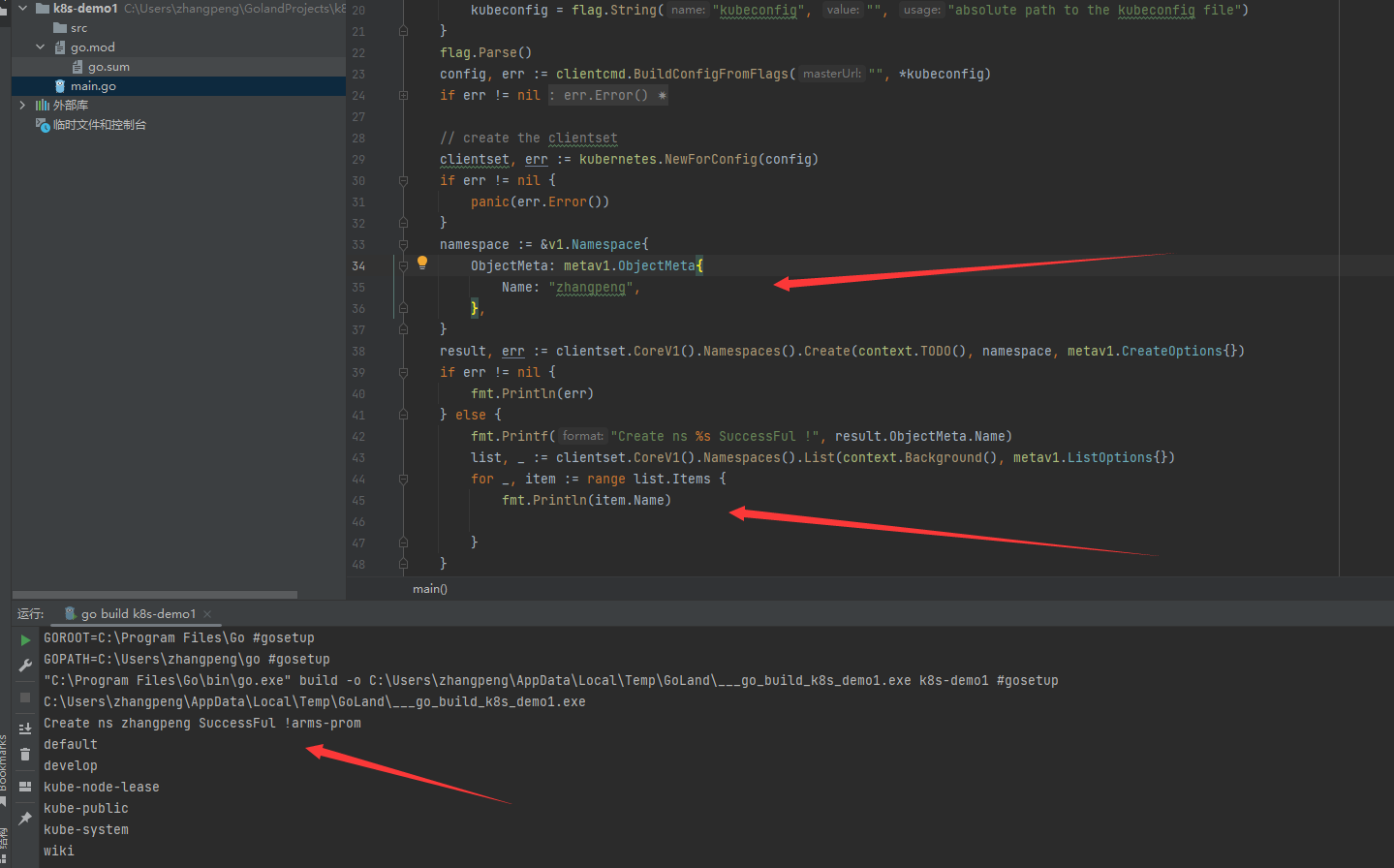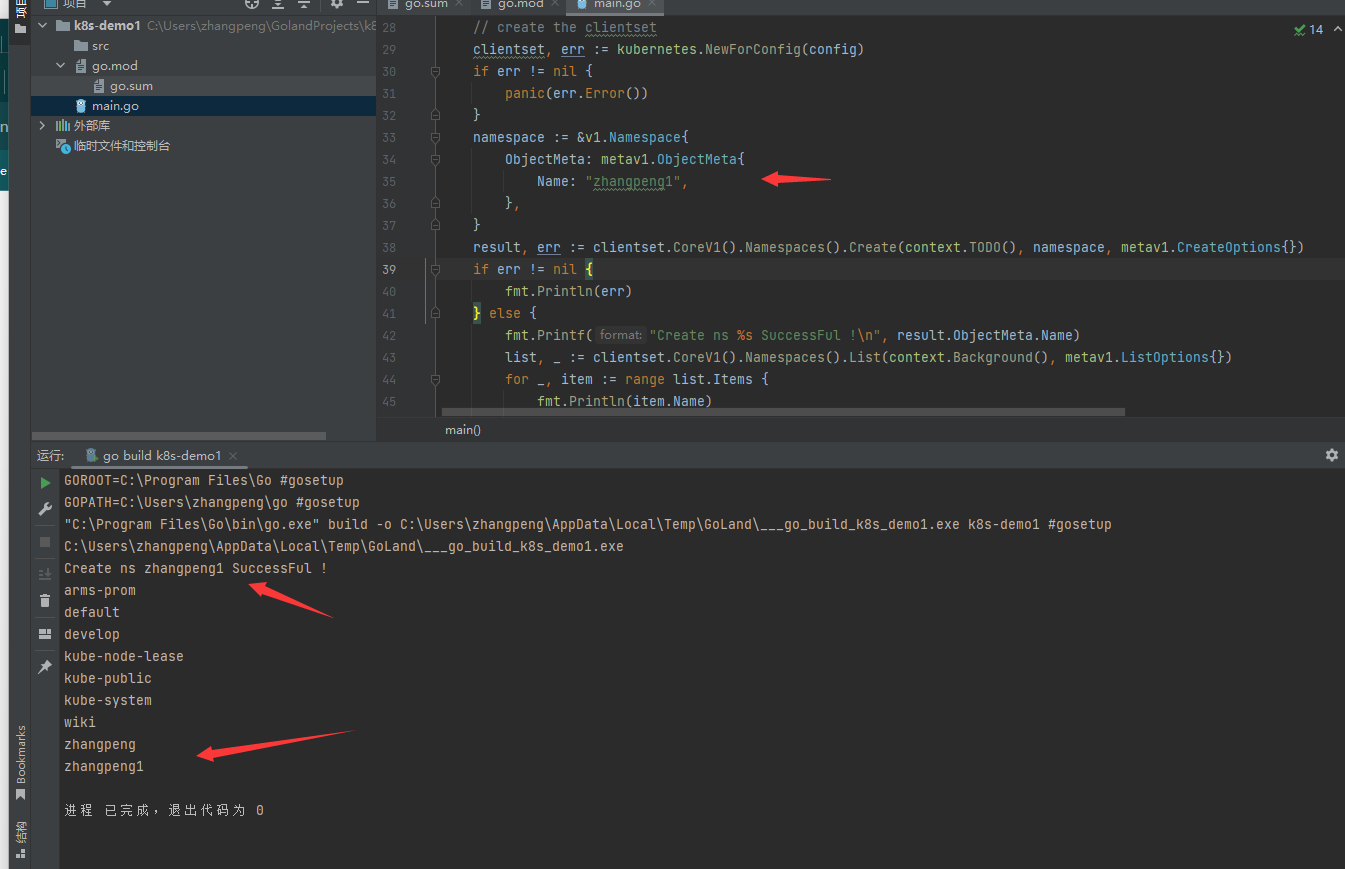背景
client-go连接kubernetes集群-connect and list。都是查看获取list列表的。现在想用client-go创建应用该如何操作呢?
client-go连接kubernetes集群-create相关操作
创建一个namespace:
clientset.CoreV1().Namespaces().Create
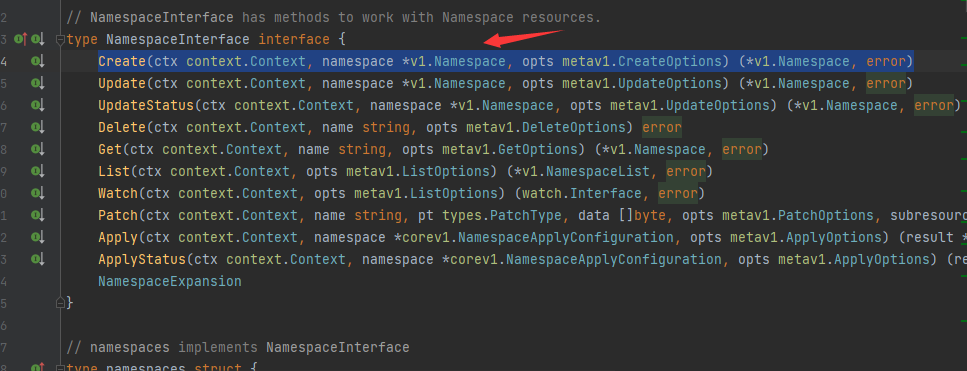
package main
import (
"context"
"flag"
"fmt"
v1 "k8s.io/api/core/v1"
metav1 "k8s.io/apimachinery/pkg/apis/meta/v1"
"k8s.io/client-go/kubernetes"
"k8s.io/client-go/tools/clientcmd"
"k8s.io/client-go/util/homedir"
"path/filepath"
)
func main() {
var kubeconfig *string
if home := homedir.HomeDir(); home != "" {
kubeconfig = flag.String("kubeconfig", filepath.Join(home, ".kube", "config"), "(optional) absolute path to the kubeconfig file")
} else {
kubeconfig = flag.String("kubeconfig", "", "absolute path to the kubeconfig file")
}
flag.Parse()
config, err := clientcmd.BuildConfigFromFlags("", *kubeconfig)
if err != nil {
panic(err.Error())
}
// create the clientset
clientset, err := kubernetes.NewForConfig(config)
if err != nil {
panic(err.Error())
}
namespace := &v1.Namespace{
ObjectMeta: metav1.ObjectMeta{
Name: "zhangpeng",
},
}
result, err := clientset.CoreV1().Namespaces().Create(context.TODO(), namespace, metav1.CreateOptions{})
if err != nil {
fmt.Println(err)
} else {
fmt.Printf("Create ns %s SuccessFul !", result.ObjectMeta.Name)
list, _ := clientset.CoreV1().Namespaces().List(context.Background(), metav1.ListOptions{})
for _, item := range list.Items {
fmt.Println(item.Name)
}
}
//fmt.Println(clientset.ServerVersion())
//list, _ := clientset.CoreV1().Namespaces().List(context.Background(), metav1.ListOptions{})
//for _, item := range list.Items {
// fmt.Println(item.Name)
//
//}
//fmt.Println("pod list in develop")
//list1, _ := clientset.CoreV1().Pods("develop").List(context.Background(), metav1.ListOptions{})
//for _, item := range list1.Items {
// fmt.Println(item.Name)
//
//}
clientset.AppsV1()
}
创建一个deployment
deployment是属于appv1的apiversion.当然了Goland中corev1().后面可以试一下补全是没有deployment的选项的!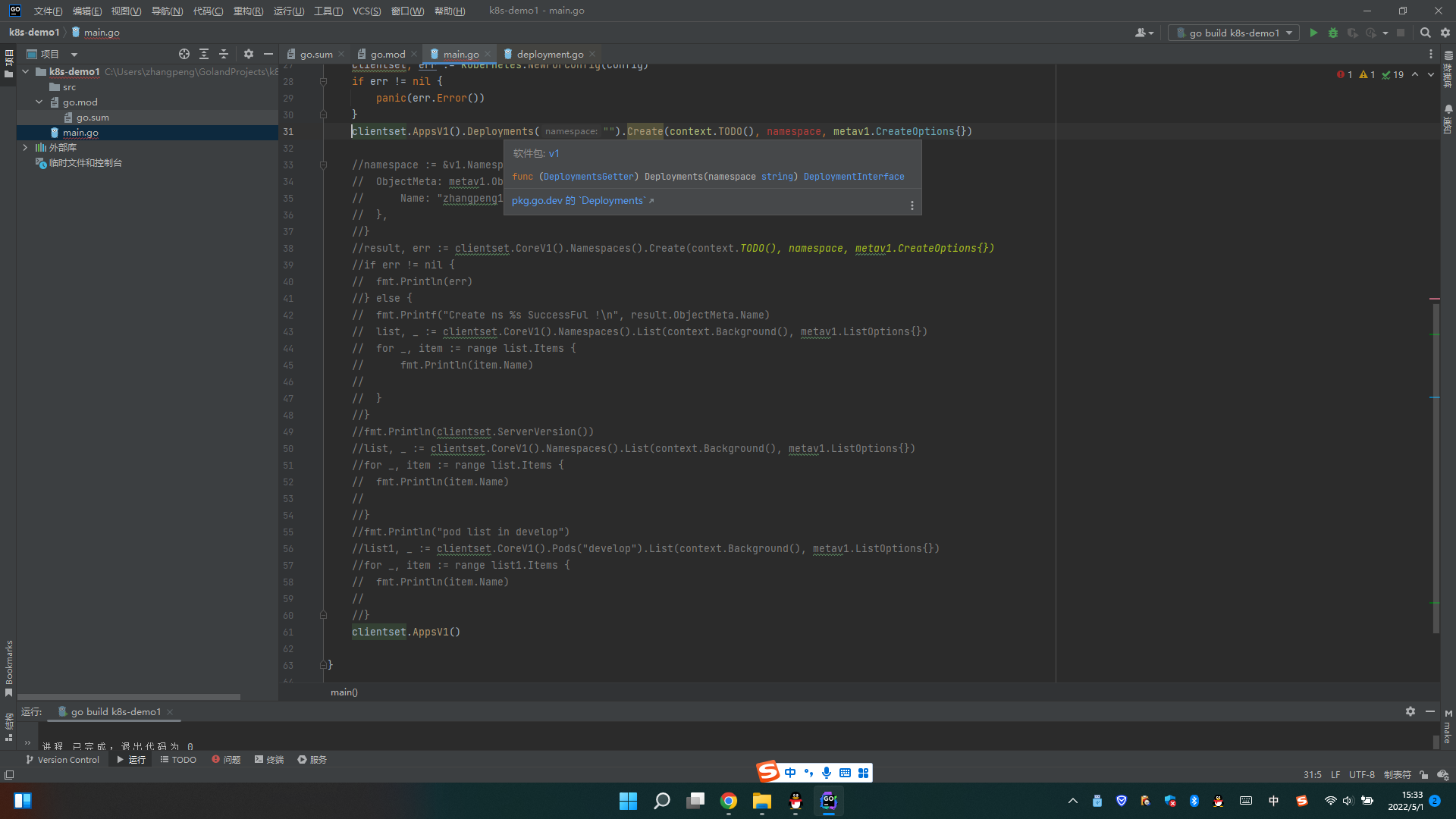
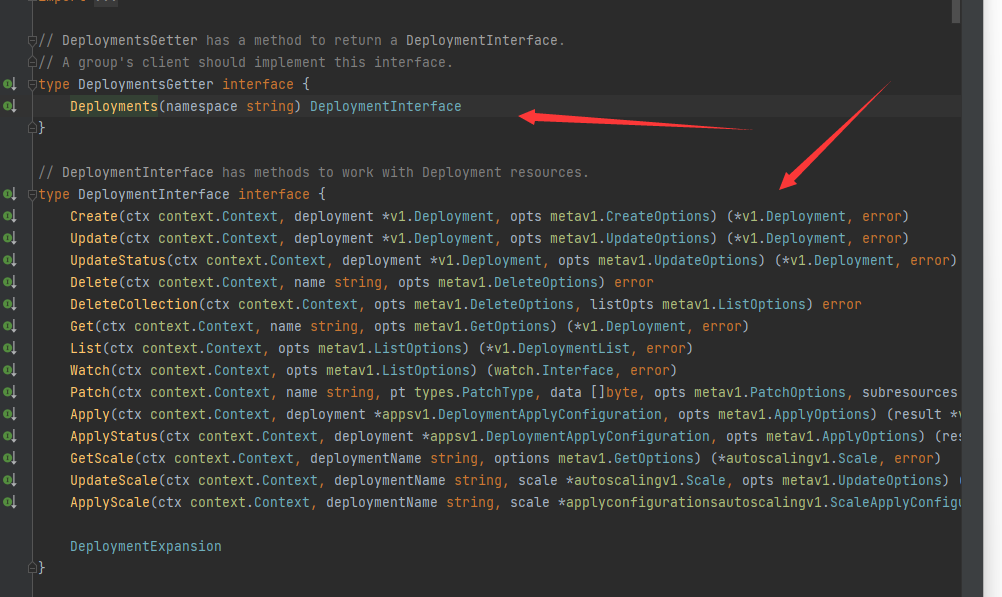
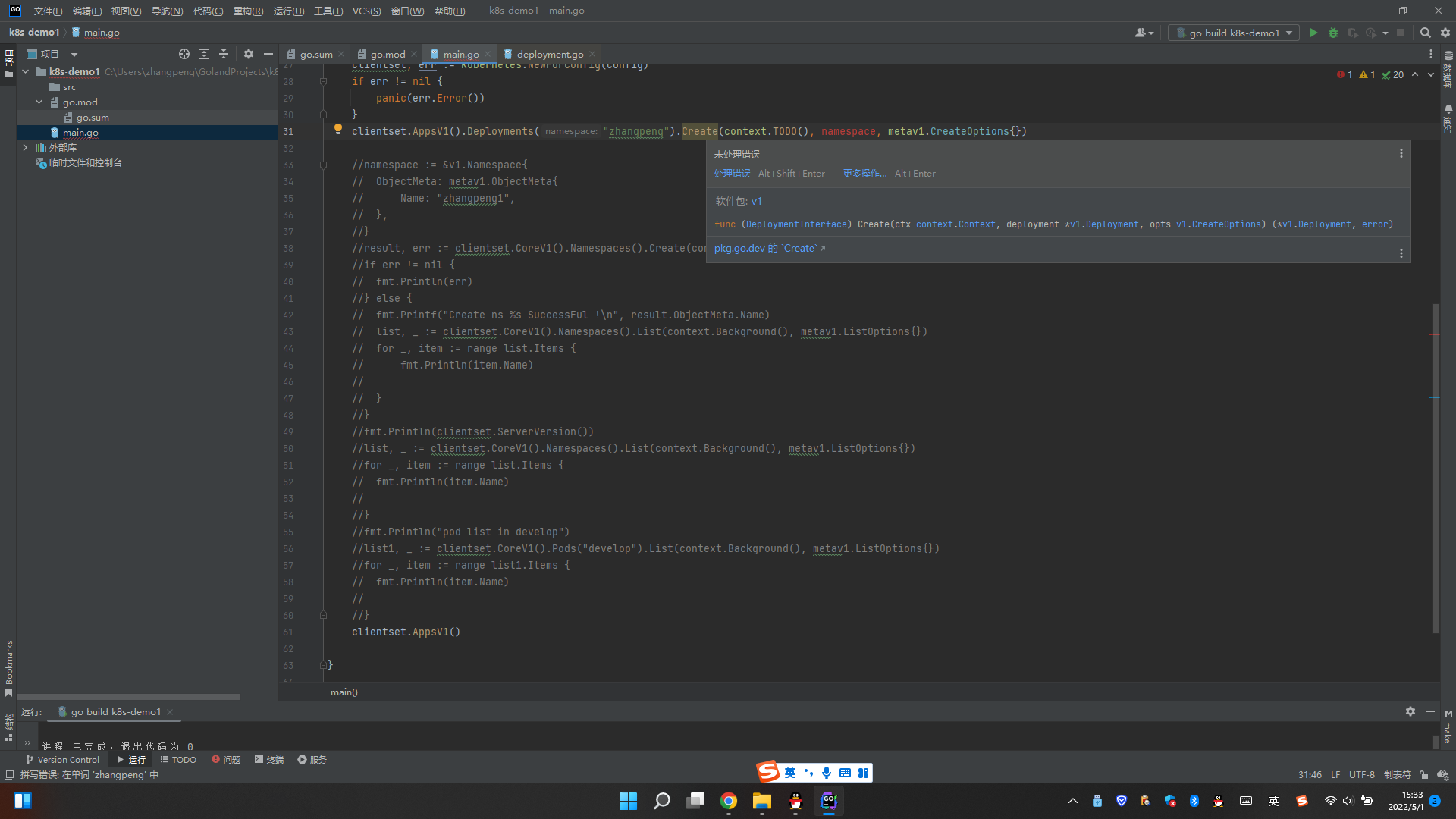
*v1.Deployment怎么处理呢?单独写一个deployment的yaml文件然后文件流读取?或者直接在go文件中定义deployment的配置?
生成yaml读取文件流的方式:
生成yaml文件
kubectl create deployment nginx --image=nginx -o yaml --dry-run=client >nginx.yaml
nginx.yaml
apiVersion: apps/v1
kind: Deployment
metadata:
creationTimestamp: null
labels:
app: nginx
name: nginx
spec:
replicas: 1
selector:
matchLabels:
app: nginx
strategy: {}
template:
metadata:
creationTimestamp: null
labels:
app: nginx
spec:
containers:
- image: nginx
name: nginx
resources: {}
status: {}
将文件保存为src/yamls/nginx.yaml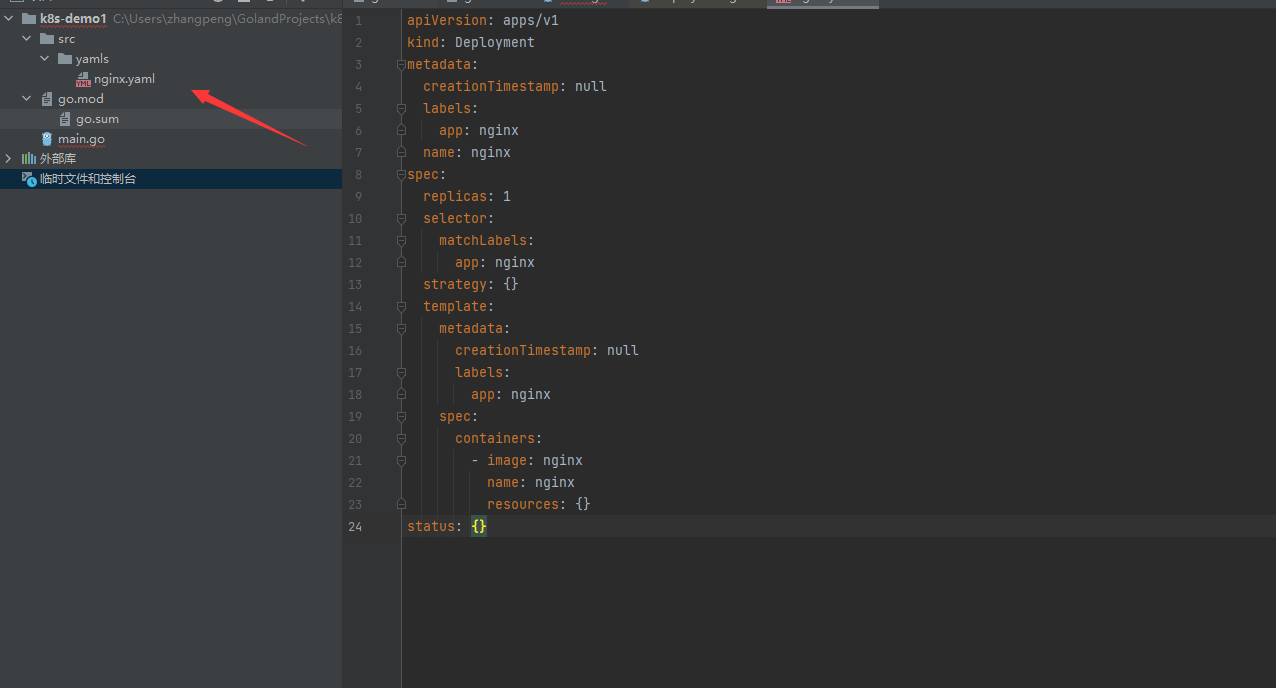
main.go
package main
import (
"context"
"encoding/json"
"flag"
"fmt"
"io/ioutil"
v1 "k8s.io/api/apps/v1"
metav1 "k8s.io/apimachinery/pkg/apis/meta/v1"
"k8s.io/apimachinery/pkg/util/yaml"
"k8s.io/client-go/kubernetes"
"k8s.io/client-go/tools/clientcmd"
"k8s.io/client-go/util/homedir"
"path/filepath"
)
func main() {
var kubeconfig *string
if home := homedir.HomeDir(); home != "" {
kubeconfig = flag.String("kubeconfig", filepath.Join(home, ".kube", "config"), "(optional) absolute path to the kubeconfig file")
} else {
kubeconfig = flag.String("kubeconfig", "", "absolute path to the kubeconfig file")
}
flag.Parse()
config, err := clientcmd.BuildConfigFromFlags("", *kubeconfig)
if err != nil {
panic(err.Error())
}
// create the clientset
clientset, err := kubernetes.NewForConfig(config)
if err != nil {
panic(err.Error())
}
b, err := ioutil.ReadFile("src/yamls/nginx.yaml")
nginxDep := &v1.Deployment{}
nginxJson, _ := yaml.ToJSON(b)
if err = json.Unmarshal(nginxJson, nginxDep); err != nil {
return
}
if _, err = clientset.AppsV1().Deployments("zhangpeng").Create(context.Background(), nginxDep, metav1.CreateOptions{}); err != nil {
fmt.Println(err)
return
}
}
go run main.go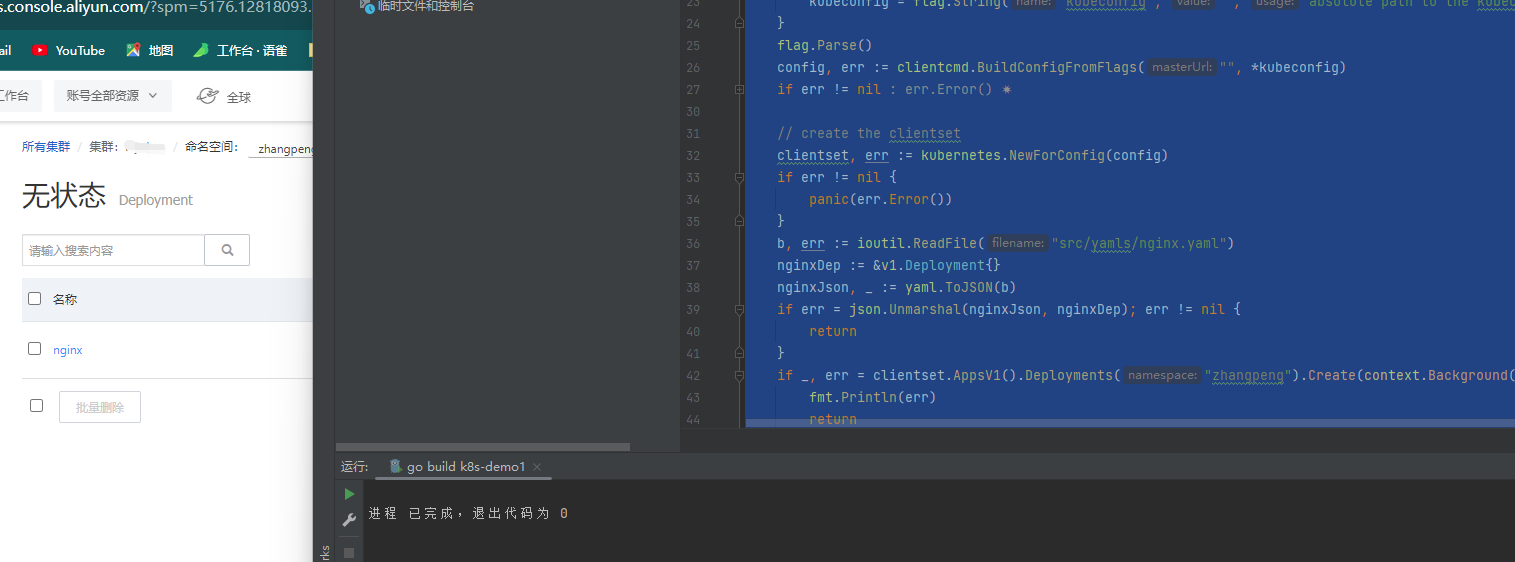
go run main.go再运行一遍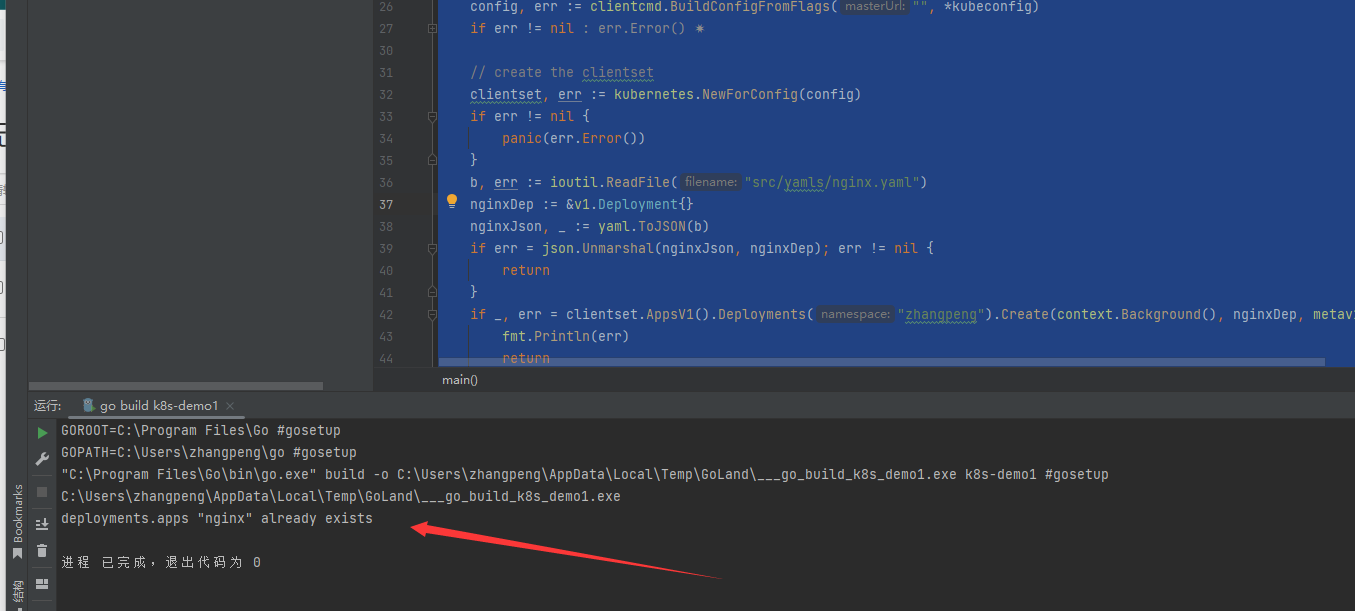
运行第二次就报错已经创建了,基本达到目标,其他的问题以后处理!
go文件中直接定义deployment的配置
package main
import (
"context"
"flag"
"fmt"
v1 "k8s.io/api/apps/v1"
corev1 "k8s.io/api/core/v1"
metav1 "k8s.io/apimachinery/pkg/apis/meta/v1"
"k8s.io/client-go/kubernetes"
"k8s.io/client-go/tools/clientcmd"
"k8s.io/client-go/util/homedir"
"path/filepath"
)
func main() {
var kubeconfig *string
if home := homedir.HomeDir(); home != "" {
kubeconfig = flag.String("kubeconfig", filepath.Join(home, ".kube", "config"), "(optional) absolute path to the kubeconfig file")
} else {
kubeconfig = flag.String("kubeconfig", "", "absolute path to the kubeconfig file")
}
flag.Parse()
config, err := clientcmd.BuildConfigFromFlags("", *kubeconfig)
if err != nil {
panic(err.Error())
}
// create the clientset
clientset, err := kubernetes.NewForConfig(config)
if err != nil {
panic(err.Error())
}
namespace := "default"
var replicas int32 = 1
deployment := &v1.Deployment{
ObjectMeta: metav1.ObjectMeta{
Name: "nginx",
Labels: map[string]string{
"app": "nginx",
"env": "dev",
},
},
Spec: v1.DeploymentSpec{
Replicas: &replicas,
Selector: &metav1.LabelSelector{
MatchLabels: map[string]string{
"app": "nginx",
"env": "dev",
},
},
Template: corev1.PodTemplateSpec{
ObjectMeta: metav1.ObjectMeta{
Name: "nginx",
Labels: map[string]string{
"app": "nginx",
"env": "dev",
},
},
Spec: corev1.PodSpec{
Containers: []corev1.Container{
{
Name: "nginx",
Image: "nginx:1.16.1",
Ports: []corev1.ContainerPort{
{
Name: "http",
Protocol: corev1.ProtocolTCP,
ContainerPort: 80,
},
},
},
},
},
},
},
}
deploymentList, err := clientset.AppsV1().Deployments(namespace).Create(context.TODO(), deployment, metav1.CreateOptions{})
fmt.Println(err, deploymentList)
}
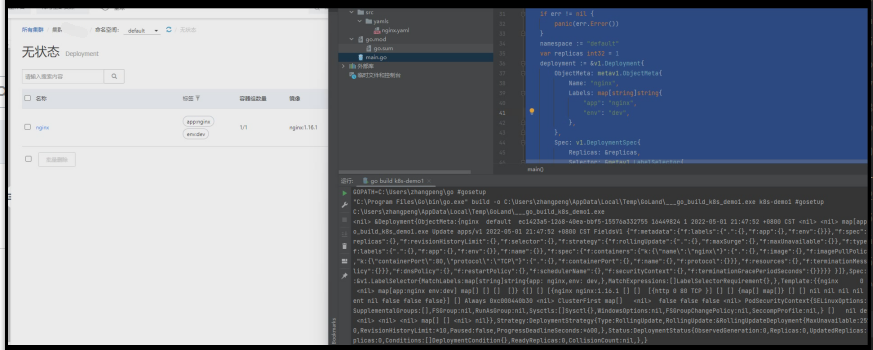
参照:https://blog.csdn.net/xujiamin0022016/article/details/123434916
以上两种方式我还是喜欢单独写yaml的方式…..
总结
- create就写这两个有代表性的了namespace and deployment.deployment还是很有代表性的……
- yaml的方式还是很方便,还是喜欢文件流的方式。
- 先简单搞一下crud。增删改查。然后想一下怎么整合一下一步一步来吧
